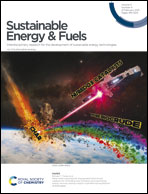Diazanyl and SnO2 bi-activated g-C3N4 for enhanced photocatalytic CO2 reduction†
Abstract
Considering the non-ideal performance of g-C3N4 on photocatalytic CO2 reduction, diazanyl and SnO2 bi-activated g-C3N4 (SnO2/HyUCN) was synthesized by changing the surface amino group into diazanyl and in situ depositing SnO2 nanoparticles via two-step redox reactions. The presence of SnO2 and diazanyl was proved by X-ray photoelectron spectroscopy (XPS) and Ag+ oxidation methods, respectively. For comparison, de-diazanyl g-C3N4 (SnO2/UCN) was also prepared. SnO2/HyUCN showed the highest photocatalytic CO2 reduction performance, and its CO generating rate reached 21.5 μmol g−1 h−1, which was 6 and 4.1 times that of pristine g-C3N4 (UCN) and SnO2/UCN, respectively. CO2 adsorption–desorption test and CO2 adsorption energy comparison based on DFT calculations revealed the enhanced CO2 adsorption of SnO2/HyUCN. The time-resolved photoluminescence (PL), surface photovoltage spectrum (SPV) and electrochemical tests revealed the suppressed recombination of photogenerated electron–hole pairs for SnO2/HyUCN. Furthermore, the photocatalytic mechanism was discussed at the molecular level by the in situ Fourier transform infrared (FT-IR) spectroscopy.



 Please wait while we load your content...
Please wait while we load your content...